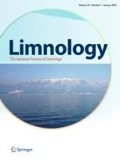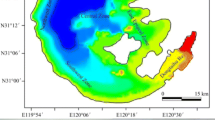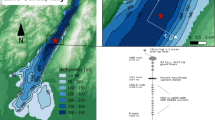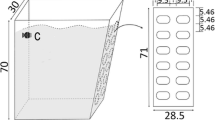Abstract
A 48-h microstructure experiment captured the variation of turbulence in Lake Biwa, Japan, during a strong stratification period, 1 week after a typhoon event. A free-fall microstructure profiler (TurboMAP) and a fine-scale profiler (F-probe) were deployed. An array of five ADCPs positioned close to the experiment site provided current measurements associated with the internal-wave field for a period of one week. Strong winds related to the passage of a typhoon close to the lake generated two low-frequency internal waves: a Kelvin wave and an inertial wave. Both waves were in the first baroclinic mode. This study pictures the superposition of two large-scale internal waves and a stronger current resulting from the two waves being in phase. The synchronization of the waves provoked enhanced shear in the hypolimnion, more than 10 m above the bottom, as well as high dissipation (10−7 W kg−1) and vertical diffusivity reaching 10−4 m2 s−1. The enhanced shear event seems to be related to the current amplitude since it occurred when the current amplitude was increased by the diel wind. Assuming the same turbulence intensity for the enhanced hypolimnetic shear events, this superposition may affect nutrient transfer in the hypolimnion. Also, we witnessed sediment resuspension, consisting of high turbidity and high fluorescence intensity, likely due to a combination of bottom stress and enhanced turbulence.









Similar content being viewed by others
References
Akaike H (1969) Power spectrum estimation through autoregressive model fitting. Phys Rev Lett 26:2352–2355
Alford M, Pinkel R (2000) Observations of overturning in the thermocline: the context of ocean mixing. J Phys Oceanogr 30:805–832
Boegman L (2009) Currents in stratified water bodies 2:internal waves. In: Lickens G (ed) Encyclopedia of inland waters, vol 1. Elsevier, Oxford, pp 539–558
Boegman L, Ivey N, Imberger J (2005) The energetic of large-scale internal wave degeneration in lakes. J Fluid Mech 531:159–180
Gangopadhyay A, Cornillon P, Jackson B (1989) Autoregressive modeling for the spectral analysis of oceanographic data. Geophys Res 94:16215–16226
Gomez-Giraldo A, Imberger J, Antenucci P (2006) Spatial structure of the dominant basin-scale internal waves in Lake Kinneret. Limnol Oceanogr 51:229–246
Imberger J (1998) Physical processes in lakes and oceans. Coastal and estuarine studies. American Geophysical Union, Washington, DC
Ivey G, Imberger J (1991) On the nature of turbulence in a stratified fluid. part i: the energetics of mixing. J Phys Oceanogr 21:650–658
Kay M (1988) Modern spectral estimation. Prentice Hall, New Jersey
Lorke A (2007) Boundary mixing in the thermocline of a large lake. J Geophys Res 112:C09019. doi:10.1029/2006JC004008
MacIntyre S, Clark F, Jellison R, Fram P (2009a) Turbulent mixing induced by nonlinear internal waves in Mono Lake, California. Limnol Oceanogr 54:2255–2272
MacIntyre S, Flynn K, Jellison R, Romero J (1999) Boundary mixing and nutrient fluxes in Mono Lake, California. Limnol Oceanogr 44:512–529
MacIntyre S, Fram J, Kushner P, Bettez N, O’Brien W, Hobbie J, Kling G (2009b) Climite-related variations in mixing dynamics in an Alaskan arctic lake. Limnol Oceanogr 54:2401–2417
Münnich M, Wüest A, Imboden M (1992) Observations of the second vertical mode of seiche in an alpine lake. Limnol Oceanogr 37:1705–1719
Oakey N (1982) Determination of the rate of dissipation of turbulent energy from simultaneous temperature and velocity shear microstructure measurements. Phys Oceanogr 12:256–271
Okamoto I, Endoh S (1995) Water mass exchange between the main basin and shiozu bay. In: Okuda S, Imberger J, Kumagai M (ed) Physical processes in a large lake, Japan. Coastal and estuarine studies, vol 48. American Geophysical Union, Washington, DC, pp 31–42
Osborn T (1980) Estimates of the local rate of vertical diffusion from dissipation measurements. J Phys Oceanogr 10:83–89
Saggio A, Imberger J (1998) Internal wave weather in stratified lake. Limnol Oceanogr 43:1780–1795
Sakai Y, Murase J, Sugimoto A, Okubo K, Nakayama E (2002) Resuspension of bottom sediment by an internal wave in Lake Biwa. Lakes Reserv Res Manag 7:339–344
Shimizu K, Imberger J, Kumagai M (2007) Horizontal structure and excitation of primary motions in a strongly stratified lake. Limnol Oceanogr 52:2641–2655
Wolk F, Yamazaki H, Seuront L, Lueck R (2002) A new free-fall profiler for measuring biophysical microstructure. Atmos Ocean Technol 19:780–793
Wüest A, Lorke A (2003) Small-scale hydrodynamics in lakes. Annu Rev Fluid Mech 35:373–412
Wüest A, Lorke A (2005) Validation of microstructure-based diffusivity estimates using tracers in lakes and oceans. In: Baumert H, Simpson J, Sundermann J (eds) Marine turbulence: theories, observations and models. Cambridge University Press, Cambridge, pp 139–152
Wüest A, Piepke G, Senden CV (2000) Turbulence kinetic energy balance as a tool for estimating vertical diffusivity in wind-forced stratified waters. Limnol Oceanogr 45:1388–1440
Wüest A, Senden CV, Imberger J, Piepke G, Gloor M (1996) Comparison of diapycnal diffusivity by tracer and microstructure techniques. Dyn Atmos Oceans 24:27–39
Acknowledgments
We thank the crew of the R/V Hakken of the Lake Biwa Environmental Research Institute for their assistance during the field experiment. We also acknowledge the technicians who fixed the TurboMAP probes. This work was financially supported by the Ministry of Education, Culture, Sports, Science and Technology of Japan. We also acknowledge the comments provided by two anonymous reviewers on the manuscript, and Ms Rosalie Rutka for her editorial work on the manuscript.
Author information
Authors and Affiliations
Corresponding author
Additional information
Handling Editor: Kazunori Akitomo.
Rights and permissions
About this article
Cite this article
Auger, G., Yamazaki, H., Nagai, T. et al. Hypolimnetic turbulence generation associated with superposition of large-scale internal waves in a strongly stratified lake: Lake Biwa, Japan. Limnology 14, 229–238 (2013). https://doi.org/10.1007/s10201-013-0401-4
Received:
Accepted:
Published:
Issue Date:
DOI: https://doi.org/10.1007/s10201-013-0401-4




